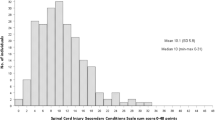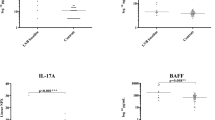Abstract
Study design
Longitudinal study.
Objectives
To assess the impact of spinal cord injury (SCI) on circulating levels of chemokines (CCL2 and CXCL10) and its relation with pain development.
Setting
National Hospital for SCI patients.
Methods
We longitudinally studied changes in the circulating levels of CCL2 and CXCL10 in 27 male patients with complete SCI who were evaluated in the early subacute phase and indeed 3 and 6 months after injury measuring at each time-point serum levels of CCL2 and CXCL10. Patients were telephonically interviewed about pain 1 year after SCI.
Results
In the early subacute phase, patients with pain showed higher CXCL10 and similar CCL2 levels as opposed to those without pain. Moreover, CCL2 concentrations were positively associated with pain intensity. The results obtained by analysing the temporal profile of the chemokines suggested that CXCL10 was inclined to decrease over time, while CCL2 increased over time.
Conclusion
The results of this preliminary study, the first performed in humans with traumatic SCI, suggest a link between changes in the circulating chemokine profile and pain development in subacute SCI stage as well as with severity in a more chronic stage. Large series studies will evaluate whether the circulating chemokine status can be useful as a biomarker for assessing the patients’ risk for pain development.
Similar content being viewed by others
Log in or create a free account to read this content
Gain free access to this article, as well as selected content from this journal and more on nature.com
or
References
Abbadie C, Bhangoo S, De Koninck Y, Malcangio M, Melik-Parsadaniantz S, White FA. Chemokines and pain mechanisms. Brain Res Rev. 2009;60:125–34.
Bonica JJ. History of pain concepts and pain therapy. Mt Sinai J Med. 1991;58:191–202.
Donnelly C, Eng JJ. Pain following spinal cord injury: the impact on community reintegration. Spinal Cord. 2005;43:278–82.
Modirian E, Pirouzi P, Soroush M, Karbalaei-Esmaeili S, Shojaei H, Zamani H. Chronic pain after spinal cord injury: results of a long-term study. Pain Med. 2010;11:1037–43.
Baron R. Mechanisms of disease: neuropathic pain—a clinical perspective. Nat Clin Pract Neurol. 2006;2:95–106.
Von Hehn CA, Baron R, Woolf CJ. Deconstructing the neuropathic pain phenotype to reveal neural mechanisms. Neuron. 2012;73:638–52.
Rowland JW, Hawryluk GW, Kwon B, Fehlings MG. Current status of acute spinal cord injury pathophysiology and emerging therapies: promise on the horizon. Neurosurg Focus. 2008;25:E2.
Ji RR, Strichartz G. Cell signaling and the genesis of neuropathic pain. Sci STKE. 2004;252:reE14.
Sommer C, Kress M. Recent findings on how proinflammatory cytokines cause pain: peripheral mechanisms in inflammatory and neuropathic hyperalgesia. Neurosci Lett. 2004;361:184–7.
Abbadie C. Chemokines, chemokine receptors and pain. Trends Immunol. 2005;26:529–34.
Scholz J, Woolf CJ. Can we conquer pain? Nat Neurosci. 2002;5(Suppl):1062–7.
Schafers M, Lee DH, Brors D, Yaksh TL, Sorkin LS. Increased sensitivity of injured and adjacent uninjured rat primary sensory neurons to exogenous tumor necrosis factor-alpha after spinal nerve ligation. J Neurosci. 2003;23:3028–38.
Kawasaki Y, Zhang L, Jen-Kun C, Ru-Rong Ji. Cytokine mechanisms of central sensitization: distinct and overlapping role of interleukin-1β, interleukin-6, and tumor necrosis factor-α in regulating synaptic and neuronal activity in the superficial spinal cord. J Neurosci. 2008;28:5189–94.
de Haas AH, Boddeke HW, Biber K. Region-specific expression of immunoregulatory proteins on microglia in the healthy CNS. Glia. 2008;56:888–94.
Biber K, Vinet J, Boddeke HW. Neuron-microglia signaling: chemokines as versatile messengers. J Neuroimmunol. 2008;198:69–74.
Miller RJ, Rostene W, Apartis E, Banisadr G, Biber K, Milligan ED, et al. Chemokine action in the nervous system. J Neurosci. 2008;28:11792–5.
Van Steenwinckel J, Reaux-Le Goazigo A, Pommier B, Mauborgne A, Dansereau MA, Kitabgi P, et al. CCL2 released from neuronal synaptic vesicles in the spinal cord is a major mediator of local inflammation and pain after peripheral nerve injury. J Neurosci. 2011;31:5865–75.
Sun JH, Yang B, Donnelly DF, Ma C, LaMotte RH. MCP-1 enhances excitability of nociceptive neurons in chronically compressed dorsal root ganglia. J Neurophysiol. 2006;96:2189–99.
Bu H, Shu B, Gao F, Liu C, Guan X, Ke C, et al. Spinal IFN-γ-induced protein-10 (CXCL10) mediates metastatic breast cancer-induced bone pain by activation of microglia in rat models. Breast Cancer Res Treat. 2014;143:255–63.
Sánchez-Ramos A, Vargas-Baquero E, Martin-de Francisco FJ, Godino-Durán JA, Rodriguez-Carrión I, Ortega-Ortega M, et al. Early spermatogenesis changes in traumatic complete spinal cord-injured adult patients. Spinal Cord. 2017;55:570–4.
Kirshblum S, Waring W 3rd. Updates for the international standards for neurological classification of spinal cord injury. Phys Med Rehabil Clin North Am. 2014;25:505–17.
Curt A, Keck ME, Dietz V. Functional outcome following spinal cord injury: significance of motor-evoked potentials and ASIA scores. Arch Phys Med Rehabil. 1998;79:81–6.
Comini-Frota ER, Teixeira AL, Angelo JP, Andrade MV, Brum DG, Kaimen-Maciel DR, et al. Evaluation of serum levels of chemokines during interferon-β treatment in multiple sclerosis patients: a 1-year, observational cohort study. CNS Drugs. 2011;25:971–81.
Mengel E, Tillmann V, Remmel L, Kool P, Purge P, Lat E, et al. Changes in inflammatory markers in estonian pubertal boys with different BMI values and increments: a 3-year follow-up study. Obesity. 2017;25:600–7.
Antonelli A, Ferri C, Fallahi P, Ferrari SM, Giuggioli D, Colaci M, et al. CXCL10 (alpha) and CCL2 (beta) chemokines in systemic sclerosis—a longitudinal study. Rheumatology. 2008;47:45–9.
Dansereau M, Gosselin R, Pohl M, Pommier B, Mechighel P, Mauborgne A, et al. Spinal CCL2 pronociceptive action is no longer effective in CCR2 receptor antagonist-treated rats. J Neurochem. 2008;106:757–69.
Brodmerkel C, Huber R, Covington M, Diamond S, Hall L, Collins R, et al. Discovery and pharmacological characterization of a novel rodent-active CCR2 antagonist, INCB3344. J Immunol. 2005;175:5370–8.
Menetski J, Mistry S, Lu M, Mudgett J, Ransohoff R, Demartino J, et al. Mice overexpressing chemokine ligand 2 (CCL2) in astrocytes display enhanced nociceptive responses. Neuroscience. 2007;149:706–14.
Ono S, Obara H, Takayanagi A, Tanabe M, Kawachi S, Itano O, et al. Suppressive effects of interleukin-18 on liver function in rat liver allografts. J Surg Res. 2012;176:293–300.
Acknowledgements
We would like to thank Rosa Maria Arriero for helpful technical help.
Funding
This research was partially supported by the Grant FISCAM PI-2006/27 (Gobierno de Castilla La Mancha) and by the Department of Economy, Industry and Competitiveness and cofinanced by the European Union (FEDER) “A way to make Europe” (SAF2016–80647-R). LMM was recipient of a grant awarded by Roche.
Author information
Authors and Affiliations
Contributions
LMM was responsible for conducting the search, extracting and analysing data, interpreting results, updating reference lists, writing the paper and revising the final paper. ASR was responsible for recruiting and evaluating the patients. FC was responsible for screening potentially eligible studies and extracting and analysing data. CAB was responsible for screening potentially eligible studies and discussing results. EVB was responsible for recruiting and evaluating the patients and revising the final paper. IBG was responsible for discussing results and revising the final paper. MR was responsible for designing the study, interpreting results and updating and revising the final paper. AO was responsible for designing the study, designing the review protocol, writing the protocol, interpreting results and writing the final paper.
Corresponding author
Ethics declarations
Conflict of interest
The authors declare that they have no conflict of interest.
Ethics
We certify that all applicable institutional and governmental regulation concerning the ethical use of human volunteers were followed during the course of this research.
Additional information
Publisher’s note: Springer Nature remains neutral with regard to jurisdictional claims in published maps and institutional affiliations.
Rights and permissions
About this article
Cite this article
Mordillo-Mateos, L., Sánchez-Ramos, A., Coperchini, F. et al. Development of chronic pain in males with traumatic spinal cord injury: role of circulating levels of the chemokines CCL2 and CXCL10 in subacute stage. Spinal Cord 57, 953–959 (2019). https://doi.org/10.1038/s41393-019-0311-3
Received:
Revised:
Accepted:
Published:
Issue date:
DOI: https://doi.org/10.1038/s41393-019-0311-3
This article is cited by
-
The neuroinflammatory triumvirate: NF-κB, NLRP3, and mTOR in spinal cord injury
Inflammopharmacology (2025)
-
Roles of Chemokines in Intervertebral Disk Degeneration
Current Pain and Headache Reports (2024)
-
Randomised, double-blind, placebo-controlled, parallel-group, multicentric, phase IIA clinical trial for evaluating the safety, tolerability, and therapeutic efficacy of daily oral administration of NFX88 to treat neuropathic pain in individuals with spinal cord injury
Spinal Cord (2024)
-
Biomaterial-supported MSC transplantation enhances cell–cell communication for spinal cord injury
Stem Cell Research & Therapy (2021)



